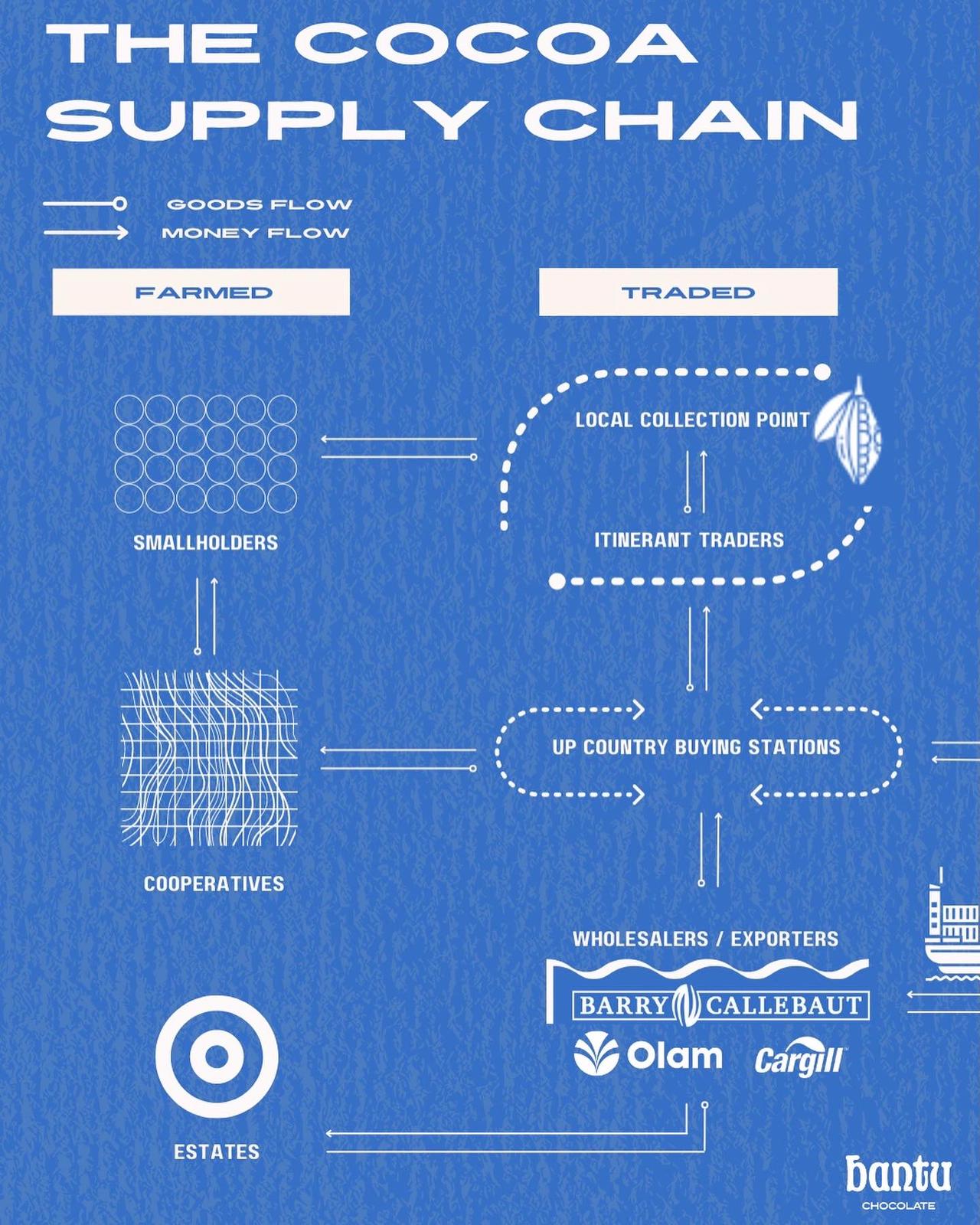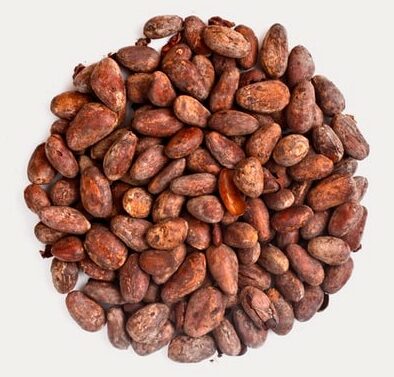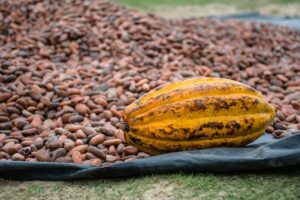
Cocoa in West Africa
May 2, 2022
A Broad Chocolate History Timeline Emphasizing Key Events
May 23, 2022Cacao Vs. Cocoa
Differences Plus Health Benefits
The difference between cacao and cocoa is not always straightforward to many folks.
When you see labels like cacao powder, cocoa powder, cacao nibs, cocoa nibs, cacao powder, cocoa powder, cacao juice, cocoa juice etc., you might wonder, “What’s the difference between cacao and cocoa?” “Are they the same thing just spelled differently? In different languages?” “If they’re different, which one is better, or even healthier?”
This article explains the difference between cacao and cocoa, together with their nutritional values, and health benefits, and helps you make better choices.
But first, it’s important to see the differences in terminology as used in the chocolate industry.
How the Chocolate Industry Uses the Labels Cacao and Cocoa
To some scholars, manufacturers, and labels, the words cacao and cocoa are the same thing just spelled differently and can be used interchangeably.
Many English-speaking countries, for example, Britain and its former African colonies, use cocoa to refer to both the plant and its finished products. French and Spanish-speaking countries use cacao. In this case, the difference between cacao and cocoa is language.
However, in the United States, especially with the rise in vegan and natural diet, the difference between cacao and cocoa is not just semantics. In this class,Cacao refers to raw materials, that is, the tree, its pod, and raw beans (or beans roasted at low temperatures). Cocoa is the product after roasting the bean, especially cocoa powder and cocoa butter.
That’s the difference adopted in this article. But to get an even clearer picture, you might want to know how cacao is processed.
The Chocolate Making Process
From the tree to chocolate or other cocoa products, the cacao bean undergoes several stages.
Fermentation: Ripe cacao beans in the pod are covered in a slimy, sugary white pulp. When removed from pods, the beans are put in boxes called sweatboxes or piled up and covered with banana leaves or mats. Depending on the species of cacao, fermentation can take anywhere from 2 to 7 days. Microbes convert the sugars in the pulp into alcohol, and the pulp cells disintegrate into a liquid that runs off.
As some of the pulp’s acidity is lost and the temperature within the beans increases, bacteria grow and convert the alcohol into acetic acid. The combined effort of alcohol, heat, and acetic acid kills the beans’ embryos, releasing their polyphenols to breakdown by enzymes. This enzymatic activity begins the formation of the desirable chocolate flavor and reduction of bitterness in the beans.
Drying: After fermentation, the beans must be dried, either under the sun or artificially. Drying serves three purposes: prevent mold formation during storage and transportation, further reduce the bitterness and acidity in the beans, and help develop the beans’ chocolate brown color. To get quality dried beans, the beans must not be dried too slowly or too quickly.
Cleaning: The dried beans are cleaned of physical contaminants like stones, dust, and iron particles.
Roasting: This stage involves, shelling, winnowing, and roasting, sometimes in different orders. The beans are roasted in special ovens heated to between 110-140 degrees Celsius for 45-70 minutes. The time depends on whether chocolate or cocoa powder is the final product. Roasting continues the development of the flavor that began with fermentation and drying. It also makes the beans or nibs (if the beans were shelled before roasting) to take on a rich brown color and acquire the distinct chocolate aroma.
Grounding: Beans (or nibs) that were not ground before roasting are then passed through an impact mill to transform them into cocoa liquor (which doesn’t contain alcohol). The liquor is now passed through a ball mill to get a thick chocolate-colored liquid called cocoa mass.
Depending on the end product, the process now takes a unique turn.
To make plain chocolate, the cocoa mass is mixed with sugar and just enough cocoa butter to help in moulding the chocolate bar. For milk chocolate destined for consumption in the United States and most of Europe, milk powder is added to plain chocolate. The process for UK markets uses condensed sugared milk instead.
To make cocoa powder, cocoa mass is pressed to remove some of the fat, also called cocoa butter. The percentage of butter removed depends on the type of powder desired. What remains after the butter is pressed out is called cocoa cake, which is then ground into cocoa powder. Many Cocoa powders are made by treating cocoa mass or nibs with potassium carbonate or sodium carbonate in a process called Dutching or alkalization. This gives the powder a darker brown color, intensifies the aroma, and further reduces acidity and bitterness.
Now that you know how the cacao bean is processed into its various end products, it’s time to get answers to another question many people ask.
What is the Difference Between Cacao Powder and Cocoa Powder?
Cacao powder is made from grinding fermented dried raw beans while cocoa powder is made from crushing cocoa cake or treating cocoa mass with either potassium carbonate or sodium carbonate in the Dutch Process.
Obviously, this means the difference between cacao powder and cocoa powder lies in taste, color, and nutrient values. Cacao powder is usually bitter and less dark but contains more antioxidants. Most packaged cocoa powders have added sugar.
But remember that some manufacturers and recipes can use cacao and cocoa interchangeably. It is safer to look at the individual nutrient values on the product label.
Which is Healthier: Cacao Powder or Cocoa Powder?
The roasting of cacao beans kills microbes that contaminated the bean during fermentation and drying. This means powder from unroasted beans, even though it contains more antioxidants and no added sugar, may not be safe.
Alkalized or Dutched cocoa powder is less acidic but contains fewer flavanols and usually has added sugar. Cocoa powder also comes in various compositions of fat content adjusted for different uses.
Which of the powders is healthier for you depends on how it was processed, its individual nutrient values, and additives. As a general rule, indulge these products moderately.
What is the Difference Between Cacao Butter and Cocoa Butter?
Cacao butter is the same as cocoa butter. This is the oil that makes up about half of the cacao seed. After grinding the roasted cocoa bean, the mixture is pressed to get cocoa butter and cocoa cake. Cocoa cake can then be ground to make cocoa powder.
Cacao vs. Cocoa: Nutritional Values
The following table compares approximate values of important nutrients per 100g of various cacao/cocoa products culled from several recipes. Cacao/cocoa products are a rich source of many minerals and vitamins, like Vitamin D2 calcium, iron, magnesium, but only the most essential nutrients appear on product labels.
| Nutrients/100g | Cacao Nibs | Unsweetened Cocoa Powder | Milk Chocolate | Dark Chocolate |
| Calories | 650 kcal | 414 kcal | 534 kcal | 553 kcal |
| Total Fat | 53.6g | 10g | 29.6g | 31.7g |
| Saturated Fat | 32.9g | 0 | 18.4g | 18.9g |
| Cholesterol | 2.1mg | 0 | 22.7mg | 8.2mg |
| Total Carbohydrate | 28.9g | 60g | 59g | 60g |
| Dietary Fiber | 16.8g | 20g | 3.4g | 7.1g |
| Sugars | 1.1g | 0 | 52.3g | 50g |
| Protein | 14.6 | 20g | 7.7g | 5g |
Note: Individual values when added up may be over 100g because Total Fat includes saturated fat and cholesterol, and Total Carbohydrate includes dietary fiber and sugars.
Health Benefits of Cacao and Cocoa
Cacao (cocoa) is rich in polyphenols, although the quantity in the finished product depends on the cacao specie and how the bean was processed. Cacao/cocoa also contain fats, proteins, caffeine, theobromine, plus minerals and vitamins.
DEEPER READ: 7 Health Benefits of Drinking Hot Cocoa
Flavanols
They are a class of polyphenols in cacao with the highest number of health benefits.
They have antioxidant effects which help the body counteract the damaging effects of free radicals. Free radicals damage cells and cause aging.
Flavanols increase the level of nitric oxide in the blood, which results in a decrease in blood pressure. They have been shown to reduce the risk of cardiovascular diseases and stroke by reducing the levels of bad cholesterol.
However, different studies arrive at varying conclusions on the impact of flavanols’ positive effects. To get a significant effect demands consumption of large amounts of chocolate per day.
Minerals and Vitamins
Cocoa powder, cocoa butter, and dark chocolate are good sources of Vitamin D2 and iron. They also contain calcium, magnesium, iron, folate, and other minerals. Their quantities vary from product to product.
Caffeine and Theobromine
These psychoactive chemicals are present in small amounts in cacao and cocoa. However, the amounts of caffeine in different chocolate bars are lower than those you’d get from a cup of coffee or tea.
Difference Between Cacao and Cocoa: The Key Takeaway
There’s no universally agreed difference between cacao and cocoa. For many, cacao refers to the cacao tree, its pods, and raw beans, while cocoa refers to the products after roasting. Yet, to others, cocoa and cacao can refer to both the tree and all its products. Different products have different nutrient composition. Pay attention to the number of calories, carbs, sugar, and fat content listed on the product labels.
References
CHOCOLATE CRISIS – Climate Change and Other Threats to the Future of Cacao by DALE WALTERS, UNIVERSITY OF FLORIDA PRESS, Gainesville
The Science of Chocolate, 2nd Edition by Stephen T Beckett, Formerly Nestle´ Product Technology Center, York, UK
Nutritional Values from www.nutritionix.com
Chocolate Extinction: Fact vs. Fiction + What Chocolate Lovers Can Do
Chocolate ExtinctionFact vs. Fiction, What Consumers Can Do Share On Facebook Twitter Email Is the world really running out of chocolate? Not really. Currently the global […]
Corporate Chocolate Gifting Ideas to Appreciate Employees and Delight Clients
Corporate Chocolate GiftingHow to Appreciate Employees & Delight Clients Share On Facebook Twitter Email When it comes to corporate gifting, a one-gift-fits-all approach just doesn't cut […]
Cacao Supper Club at Home: Guide to Tasting Chocolate, Cacao Tea, and Pulp Juice
Cacao Supper Club at HomeGuide to Tasting Chocolate, Cacao Tea, and Pulp Juice Share On Facebook Twitter Email Imagine gathering around the table with a few […]






